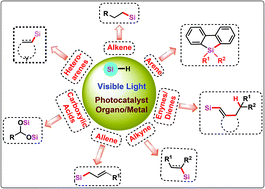Visible-light-induced silylation: an update
Abstract
Visible-light-driven functionalization of various organic systems has proved to be extremely successful and reached an impressive level of sophistication as well as efficiency in the last two decades. At the same time, organosilicon compounds are significant due to their promising applications in therapeutic agents, drug delivery, building blocks and so on. More interestingly, they are cheap, operationally simple, highly stable, less toxic and easy to handle. In this scenario, an environment-friendly synthetic approach for silylation, such as visible-light-induced silylation, is in high demand at present for molecule construction having the C–Si bond. This perspective summarizes the recent findings and developments in the emerging area of photocatalytic silylation with literature coverage mainly extending from 2014 to February 2021.

- This article is part of the themed collection: Synthetic methodology in OBC


 Please wait while we load your content...
Please wait while we load your content...